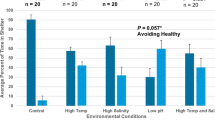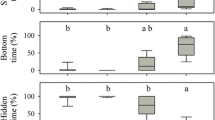Abstract
The locomotor activity patterns and agonistic encounters of cultured juvenile (IX–XIII stage) American lobsters, Homarus americanus (Milne-Edwards) held in 8 experimental environments were investigated to examine their relative contribution to aggressive level. Three variables: (1) lobsters individually or communally maintained, (2) shelters present or absent, and (3) open or closed seawater system were tested in a set of factorial experiments. Locomotor activity of lobsters held in a 12 h: 12 h light: dark regime was recorded for individually separated lobsters for the first 5 days and for communally held lobsters for the next 5 days of a 10-day experimental period. All lobsters maintained individually had similar levels of activity. When the same individuals were communally maintained, there appeared to be social inhibition of activity. In addition, communally held lobsters without shelter were twice as active as those provided with shelter. The activity levels of groups of communally held lobsters with shelter progressively decreased over the experimental period. All lobsters became somewhat entrained to the light: dark cycle and were nocturnally active. However, the degree of entrainment was strongly influenced (P<0.001) by the presence or absence of shelter and other lobsters. Individually maintained lobsters all showed good entrainment, although those provided with shelter were slightly better entrained. The presence of conspecifics desynchronized activity patterns when shelter was not provided. Aggressive level, as measured by the frequency of agonistic encounters per 15-min observation period and the number and types of displays per encounter, decreased over an 8-day period for groups of 3 lobsters in all experimental environments. Lobsters maintained in a closed system initially showed higher frequencies of agonistic encounters than those held in an open system. The observed decrease in aggressive level with time primarily resulted from decreased activity levels. When two lobsters met, the probability of an agonistic encounter was about 0.8 throughout the experimental period, but decreasing activity levels resulted in progressively fewer encounters. The results suggest several approaches for limiting aggression among communally maintained lobsters in culture systems by environmental manipulation.
Similar content being viewed by others
Literature Cited
Aiken, D.E.: Proecdysis, setal development, and molt prediction in the American lobster. J. Fish. Res. Bd Can. 30, 1337–1344 (1973)
Allen, J.A.: The rhythms and population dynamics of decapod Crustacea. Oceanogr. mar. Biol. A. Rev. 4, 247–265 (1966)
Atema, J. and D. Engstrom: Sex pheromone in the lobster (Homarus americanus). Nature, Lond. 232, 261–263 (1971)
Atkinson, R.J.A.: The activity rhythm of Goneplax rhomboides (L.). Mar. Behav. Physiol. 2, 325–335 (1974)
— and E. Naylor: Activity rhythms in some burrowing decapods. Helgoländer wiss. Meeresunters. 24, 192–201 (1973)
Berrill, M. and R. Stewart: Tunnel-digging in mud by newly-settled American lobsters, Homarus americanus. J. Fish. Res. Bd Can. 30, 285–287 (1973)
Bovbjerg, R.V.: Dominance order in the crayfish Orconectes virilis (Hagen). Physiol. Zoöl. 26, 173–178 (1953)
— Density and dispersal in laboratory crayfish populations. Ecology 40, 504–506 (1959)
Bregazzi, P.K. and E. Naylor: The locomotor activity rhythm of Talitrus saltator (Montagu) Crustacea, Amphipoda. J. exp. Biol. 57, 375–391 (1972)
Bruce, V.G.: Environmental entrainment of circadian rhythms. Cold Spring Harb. Symp. quant. Biol. 25, 29–47 (1960)
Cobb, J.S.: Activity, growth, and shelter selection of the American lobster, 172 pp. Ph.D. Thesis, University of Rhode Island, Kingston 1969
—: The shelter-related behavior of the lobster, Homarus americanus. Ecology 52, 108–115 (1971)
— and G.R. Tamm: Social conditions increase intermolt period in juvenile lobsters Homarus americanus. J. Fish. Res. Bd Can. 32, 1941–1943 (1974)
Courchesne, E. and G.W. Barlow: Effect of isolation on components of aggressive and other behavior in the hermit crab, Pagurus samuelis. Z. vergl. Physiol. 75, 32–48 (1971)
Douglis, M.: Some evidence of a dominance-subdominance relationship among lobsters, Homarus americanus. (Abstract only). Anat. Rec. 96, p. 553 (1946)
Dunham, P.: Some effects of group housing upon the aggressive behavior of the lobster Homarus americanus. J. Fish. Res. Bd Can. 29, 598–601 (1972)
Enright, J.T.: The tidal rhythm of activity of a sand-beach amphipod. z. vergl. Physiol. 46, 276–313 (1963)
—: The search for rhythmicity in biological time series. J. theor. Biol. 8, 426–468 (1965)
Hagerman, L.: Locomotory activity patterns of Crangon vulgaris (Fabricius) (Crustacea, Natantia). Ophelia 8, 255–266 (1970)
Hazlett, B.A.: Effects of crowding on the agonistic behavior of the hermit crab Pagurus bernhardus. Ecology 49, 573–575 (1968)
—, D. Rubenstein and D. Rittschof: Starvation, energy reserves and aggression in the crayfish Orconectes virilis (Hagen, 1870) (Decapoda, Cambaridae). Crustaceana 28, 11–16 (1975)
Herrick, F.H.: Natural history of the American lobster. Bull. Bur. Fish., Wash. 29, 149–408 (1909)
Hughes, J.T.: Lobster culture. In: Culture of marine invertebrate animals, pp 221–227. Ed. by W.L. Smith and M.H. Chanley. New York: Plenum Press 1972 (Proc. Cult. mar. Invert. Anim., Greenport, N.Y., Oct., 1972)
Kampa, E., B. Abbott and B. Boden: Some aspects of vision in the lobster Homarus vulgaris in relation to the structure of its eye. J. mar. biol. Ass. U.K. 43, 683–699 (1963)
Kensler, C.B.: The potential of lobster culture. Am. Fish. Fmr Wld Aquacult. News 1, 8–12 (1970)
Krekorian, D.O., D.C. Sommerville and R.F. Ford: Laboratory study of behavioral interactions between the American lobster, Homarus americanus, and the California spiny lobster, Panulirus interruptus, with comparative observations on the rock crab, Cancer antennarius. Fish. Bull. U.S. 72, 1146–1159 (1974)
McLeese, D.W.: Detection of dissolved substances by the American lobster (Homarus americanus) and olfactory attraction between lobsters. J. Fish. Res. Bd Can. 27, 1371–1378 (1970)
—: Chemical communication among lobsters (Homarus americanus). J. Fish. Res. Bd Can. 30, 775–778 (1973)
Moller, T.J. and D.A. Jones: Locomotory rhythms and burrowing habits of Penaeus semisulcatus (de Haan) and P. monodon (Fabricius) (Crustacea: Penaeidae). J. exp. mar. Biol. Ecol. 18, 61–67 (1975)
O'Neil, D.: Some factors influencing the outcome of shelter competition in the American lobster, Homarus americanus (Decapoda, Crustacea), 59 pp. M.S. Thesis, University of Rhode Island, Kingston, R.I. 1974
Sale, P.F.: A suggested mechanism for habitat selection by the juvenile manini Acanthurus triostegus sandvicensis (Streets). Behaviour 35, 27–44 (1969)
Sastry, A.N.: An experimental culture-research facility for the American lobster, Homarus americanus. Proc. Eur. mar. biol. Symp. 10, 419–435 (1975)
— and L. Zeitlin-Hale: Survival of communally reared larval and juvenile lobsters, Homarus americanus. Mar. Biol. 39, 297–303 (1977)
Schuur, A.M., P.A. Allen and L.W. Bostford: Analysis of the facilities for commercial production of Homarus americanus. Pap. Am. Soc. agric. Engrs 74–5517, 1–19 (1974)
Scrivner, J.C.E.: Agonistic behavior of the American lobster Homarus americanus (Milne-Edwards). Tech. Rep. Fish. Res. Bd Can. 235, 1–128 (1971)
Shleser, R. and G. Tchobanoglous: The American lobster as a model for the continuous production of quality seafood through aquaculture. J. mar. tech. Soc. 8, 4–8 (1974)
Squires, H.J.: Lobster (Homarus americanus) fishery and ecology in Port au Port Bay, Newfoundland 1960–1965. Proc. natn. Shellfish. Ass. 60, 22–39 (1970)
Stephens, G.J., F. Halberg and G.C. Stephens: The blinded fiddler crab: an invertebrate model of circadian desynchronization. Ann. N.Y. Acad. Sci. 117, 386–406 (1964)
Stewart, J.E. and H.J. Squires: Adverse conditions as inhibitors of ecdysis in the lobster Homarus americanus. J. Fish. Res. Bd Can. 25, 1763–1774 (1968)
Wilder, D.G.: Artificial rearing of lobsters. Fish. Can. 23, 14–15 (1971)
Zeitlin-Hale, L.: Effects of environmental manipulation on the locomotor activity and agonistic behavior of juvenile American lobsters Homarus americanus, 131 pp. M.S. Thesis, University of Rhode Island, Kingston, R.I. 1975
Author information
Authors and Affiliations
Additional information
Communicated by M.R. Tripp, Newark
Rights and permissions
About this article
Cite this article
Zeitlin-Hale, L., Sastry, A.N. Effects of environmental manipulation on the locomotor activity and agonistic behavior of cultured juvenile American lobsters, Homarus americanus . Mar. Biol. 47, 369–379 (1978). https://doi.org/10.1007/BF00388929
Accepted:
Issue Date:
DOI: https://doi.org/10.1007/BF00388929




